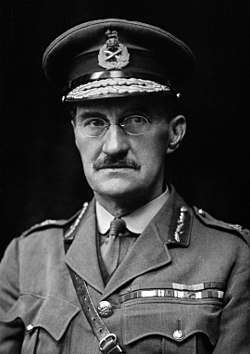William Babtie
Lieutenant General Sir William Babtie, VC, KCB, KCMG (7 May 1859 – 11 September 1920) was a Scottish recipient of the Victoria Cross, the highest and most prestigious award for gallantry in the face of the enemy that can be awarded to British and Commonwealth armed forces. His Victoria Cross is displayed at the Army Medical Services Museum in Aldershot.
Sir William Babtie | |
|---|---|
 | |
| Born | 7 May 1859 Dumbarton, Scotland |
| Died | 11 August 1920 (aged 61) Knokke, Belgium |
| Buried | Stoke Cemetery, Guildford |
| Allegiance | |
| Service/ | |
| Years of service | 1881–1919 |
| Rank | Lieutenant General |
| Unit | Royal Army Medical Corps |
| Commands held | Director General Army Medical Services |
| Battles/wars | |
| Awards | |
Babtie graduated from the University of Glasgow with an M.B. and also received the LRCP and LRCS from the University of Edinburgh Medical School in 1880.
South Africa and the Victoria Cross
Babtie was 40 years old, and a major in the Royal Army Medical Corps,[1] British Army during the Second Boer War on 15 December 1899 at the Battle of Colenso, South Africa when he won his VC. He exposed himself to heavy fire to tend to the wounded including going with Captain Walter Norris Congreve to bring in Lieutenant Frederick Hugh Sherston (The Hon.) Roberts who was lying wounded on the veldt. The full citation was published in the London Gazette on 20 April 1900 and reads:[2]
At Colenso, on the l0th December, 1899, the wounded of the 14th and 66th Batteries, Royal Field Artillery, were lying in an advanced donga close in the rear of the guns without any Medical Officer to attend to them, and when a message was sent back asking for assistance, Major W. Babtie, R A.M.C., rode up under a heavy rifle fire, his pony being hit three times. "When he arrived at the donga, where the wounded were lying in sheltered corners, he attended to them all, going from place to place exposed to the heavy rifle fire which greeted anyone who showed himself. Later on in the day, Major Babtie went out with Captain Congreve to bring in Lieutenant Roberts, who was lying wounded on the veldt. This also was under a heavy fire.
He had previously been made a Companion of the Order of St Michael and St George (CMG) in June 1899 for services rendered in the occupation of Crete.[3]
After South Africa
Babtie was promoted to lieutenant-colonel on 29 November 1900,[4] and was in early January 1901 appointed for temporary duties in the Home District as he returned to the United Kingdom.[5] He was appointed Assistant-Director, Army Medical Service in that June.[6] In 1903 he was made a Knight of the Venerable Order of Saint John.[7] He was promoted to colonel in 1907, and appointed Inspector of Medical Services.[8][9] In 1910 he was appointed Deputy Director-General of Medical Services and granted the temporary rank of surgeon-general.[10] The rank was made permanent in 1911.[11] He was made a Companion of the Bath (CB) in the 1912 King's Birthday Honours.[12] On 1 June 1914 he was appointed Honorary Surgeon to the King,[13] holding the post until 7 May 1919.[14]
First World War—Mesopotamia and Dardanelles
Babtie was appointed Director, Medical Services for the British Indian Army in March 1914.[15] He was responsible for medical provision on both the Mesopotamian campaign and the Dardanelles Campaign. He was Mentioned in Despatches for his services in the Dardanelles.[16] He was appointed Director of Medical Services at the War Office on 18 March 1916.[17] He became Inspector of Medical Services with the temporary rank of lieutenant-general on 1 March 1918.[18]
However, he was severely criticised by the Mesopotamia Commission of Inquiry and received further criticism for similar failings at Gallipoli.[19]
He was made a Knight Commander of the Order of the Bath (KCB) in the 1919 King's Birthday Honours.[20]
References
- "No. 26438". The London Gazette. 5 September 1893. p. 5059.
- "No. 27184". The London Gazette. 20 April 1900. p. 2547.
- "No. 27091". The London Gazette. 20 June 1899. p. 3865.
- "No. 27306". The London Gazette. 19 April 1901. p. 2706.
- "Naval & Military intelligence". The Times (36341). London. 2 January 1901. p. 8.
- "No. 27326". The London Gazette. 25 June 1901. p. 4251.
- "No. 27550". The London Gazette. 8 May 1903. p. 2921.
- "No. 28004". The London Gazette. 15 March 1907. p. 1833.
- "No. 28014". The London Gazette. 19 April 1907. p. 2650.
- "No. 28346". The London Gazette. 8 March 1910. p. 1684.
- "No. 28562". The London Gazette. 15 December 1911. p. 9450.
- "No. 28617". The London Gazette (Supplement). 11 June 1912. pp. 4297–4298.
- "No. 31488". The London Gazette (Supplement). 1 August 1919. p. 9948.
- "Babtie, Lt-Gen. Sir William, (7 May 1859-11 Sept. 1920), Hon. Surgeon to His Majesty, 1914-19; a Knight of Grace of the Order of St John of Jerusalem in England". www.ukwhoswho.com. doi:10.1093/ww/9780199540884.013.u192969. Retrieved 30 January 2019.
- "No. 28831". The London Gazette (Supplement). 15 May 1914. p. 3931.
- "No. 29569". The London Gazette (Supplement). 5 May 1916. pp. 4517–4519.
- "No. 29596". The London Gazette. 26 May 1916. p. 5206.
- "No. 30628". The London Gazette. 12 April 1918. p. 4490.
- firstworldwar.com
- "No. 31395". The London Gazette. 6 June 1919. p. 7425.
- Monuments to Courage (David Harvey, 1999)
- The Register of the Victoria Cross (This England, 1997)
- Scotland's Forgotten Valour (Graham Ross, 1995)
- Victoria Crosses of the Anglo-Boer War (Ian Uys, 2000)
External links
| Wikimedia Commons has media related to William Babtie. |
- Burial location of William Babtie "Surrey"
- Location of William Babtie's Victoria Cross "Army Medical Services Museum"
- Anglo-Boer War.com